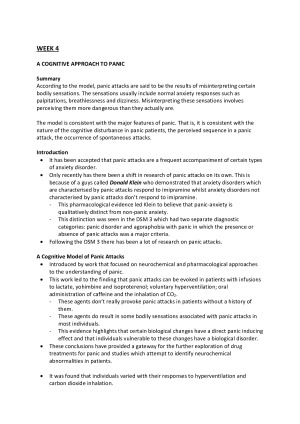PSYC2101 ARTICLE AND TEXTBOOK READINGS
Subject notes for UNSW PSYC2101
Description
HD quality notes. Clear, concise explanations with diagrams. All reading content included for the semester including, - Schwartz, S. (1993). Classic Studies in Abnormal Psychology. - Patterson, G. R., Dishion, T. J., & Bank, L. (1984). Family interaction: A process model of deviance training. Aggressive Behavior, 10,. - Wells, A., Clark, , Salkovskis, P., Ludgate, J., Hackmann, A., & Gelder, M. (1995). Social phobia: The role of in-situation safety behaviours in maintaining anxiety and negative beliefs. Behavior Therapy, 26,. - Clark, D. M. (1986). A cognitive approach to panic. Behaviour Research and Therapy, 24,. - Rapee, R. M., & Heimberg, R. G. (1997). A cognitive-behavioral model of anxiety in social phobia. Behavior Research and Therapy, 35(8), - Abramowitz, J. S., Whiteside, S., Kalsy, S. A., & Tolin, D. F. (2003). Thought control strategies in obsessive-compulsive disorder: A replication and extension. Behaviour Research and Therapy, 41,. - Kaufman, A. S., & Lichtenberger, E. O. (2006). Assessing Adolescent and Adult Intelligence. Hoboken, NJ: John Wiley & Sons. - Deary, I. J., Pattie, A., & Starr, J. M. (2013). The stability of intelligence from age 11 years to age 90 years: The Lothian birth cohort of 1921. Psychological Science, 24(12),. - Keel, P. K., & Klump, K. L. (2003). Are eating disorders culture-bound syndromes? Implications for conceptualizing their etiology. Psychological Bulletin, 129,. - Neumark-Sztainer, D. (2005). Can we simultaneously work toward the prevention of obesity and eating disorders in children and adolescents? International Journal of Eating Disorders, 38,. - Ehlers, A. & Clark, D. M. (2000). A cognitive model of posttraumatic stress disorder. Behaviour Research and Therapy, 38,. - McGinn, L. K., & Sanderson, W. C. (2001). What allows cognitive behavioral therapy to be brief? Overview, efficacy, and crucial factors facilitating brief treatment. Clinical Psychology: Science and Practice, 8, 23-37. - Blakemore, S. J., Smith, J., Steel, R., Johnstone, E. C., and Frith, C. D. (2000). Hallucinations and passivity experiences: Evidence for a breakdown in self-monitoring. Psychological Medicine, 30,. - Clark, L. A. (2009). Stability and change in personality disorder. Current Directions in Psychological Science, 18(1), 27-31. - Hare, R. D. (1996). Psychopathy and antisocial personality disorder: A case of diagnostic confusion. Psychiatric Times, 13(2), 39-40. TEXTBOOK READINGS (COMPULSORY) Week 1: Chapter 1, Abnormal psychology: Past and present Week 2: Chapter 4, Clinical assessment, diagnosis, and treatment Week 3: Chapter 17, Disorders common among children and adolescents Week 4: Chapter 5, Anxiety, obsessive-compulsive, and related disorders Week 7: Chapter 11, Eating disorder Week 8: Chapter 7, Depressive and bipolar disorders Week 9: Chapter 6, Disorders of trauma and stress Week 10: Chapter 3, Models of abnormality Week 11: Chapter 14, Schizophrenia and related disorders Week 12: Chapter 16, Personality disorders
UNSW
Semester 2, 2018
69 pages
27,731 words
$39.00
17
Campus
UNSW, Kensington
Member since
February 2017
